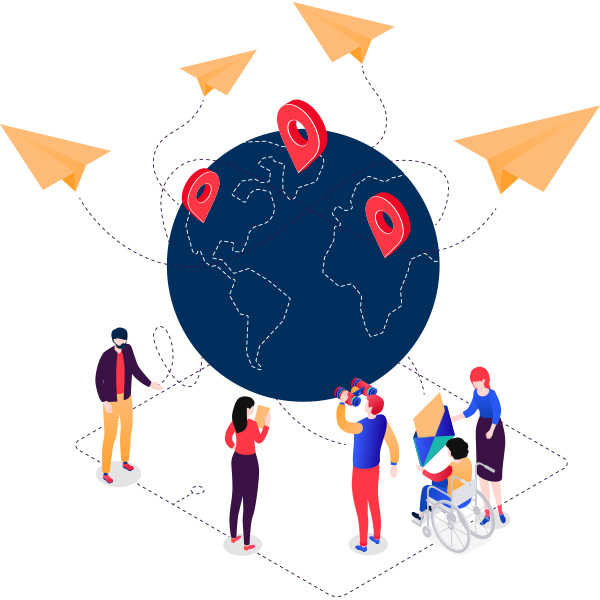What an exciting time to be alive.
Technology is moving at an ever increasing pace. Computing power is doubling every two years. Internet speeds have gone from taking hours to download a song to minutes to download an entire high definition feature-length movie. We live in an age of supercomputers, autonomous vehicles, voice assistants in our homes, and artificial intelligence managing our email inboxes.
Our current world is experiencing an incredibly fast transformation -- faster than any other era mankind has lived through. And the way we send communications to our customers and prospects is transforming, too, which is why I decided to write about this topic.
If you think it's going to be safe to do more of the same now or in the future...it's not, and I'll explain why in this article.
Before we address the major pillars of change, I think it's wise to first identify the main channels of communication today.
The Modes Of Communication

The way we communicate hasn't really changed that much in the last decade. Here are the standard methods (in no order of importance) that we're using on a regular basis:
- 1Phone
- 2Email
- 3Standard Mail
- 4Community Forum
- 5Print
Throughout this article I will be referencing these modes of communication and explain why they are under attack. Giving you a brief backstory of how they were used (and then abused) will bring you full understanding about the predicament we are in.
The Golden Era
As each of these modes of communication became widely used and more affordable, methods of mass communication became a tool that nearly every marketer could use to reach their prospects.
- We could cold call prospects and....people actually answered the phone!
- We could easily hit the inbox and figure out one of the three variations of the email syntax (j.doe@, john.doe@, johndoe@) to reach that prospect's inbox.
- People actually read the physical mail they received.
- Communicating with prospects in online forums was easy and trusted.
- And print? People subscribed to magazines and newspapers and would read the ads and articles.
As marketers, we had it pretty good! And then, every single one of those channels were abused to a point that disruption happened and reaching those same people changed (and not in a good way, either).
The Great Disconnect

The phone.
Remember when you'd answer your phone even if you didn't recognize the number? If you did miss a call, you would usually call that number back saying "Hello, I just missed a call from this number." That doesn't happen anymore. And I'm willing to bet you don't answer any number you don't recognize. The purpose of the phone and how it's used is an entirely different experience.

The inbox.
The term "spam" came from the sheer volume of unsolicited junk we received, and mostly still do, from offenders sending us everything from "you have inherited a large sum of money from a prince" to business solicitations breaking all Federal Anti-CAN Spam Act laws with no "unsubscribe" options. Our inboxes were so abused that ESP's created spam filters, promotions tabs, rules, and -- the newest threat we will discuss in more depth -- artificial intelligence. Hitting the inbox has never been more difficult and it's going to get much, much harder in the years to come.

The mailbox.
The days when mail was something that you actually opened is long gone for most. Important things were sent using this mode of communication. Checks, bills, letters from family and friends, pictures... things of value and things of importance arrived in your mailbox. Rarely now will the contents of what arrives in your mailbox get anymore than 30-60 seconds of attention and I'm willing to bet 99% of it is thrown away immediately. The onslaught of junk mail, junk magazines, coupons, grocery store circulars, and computer generated letters from realtors asking if you want to sell your home have dominated the mailboxes of our homes.

The forum.
Before we had Facebook (even before Myspace), there were forums. You could connect with a community of people who shared similar interests. Time progressed and Facebook came out. We could reach our audience by creating groups and running ads. Then, Facebook decided to reduce the exposure of your own posts to your own groups to as low as 20%. That means you send a post to your group, and maybe, if you're lucky, 20 out of every 100 members would see the post in their newsfeed. Next, the distribution of ads exploded. Algorithms identify your audience, and then serve up your competitors' ads to them! Then, more and more communities popped up: Snapchat, Instagram, Pinterest, LinkedIn. People don't know where to go with so many options, and even worse, they are seeing as many as 2,000 ads per day. It's Advertising Overwhelm.

The magazine and newspaper.
As places like Google, Bing, and Yahoo began to serve up news on their homepages, and social channels became an actual source of news (sad, but true), newspaper readership declined. Advertisers followed suit and we are now seeing the slow death of the newspaper industry. Magazines, pushing to drive higher profits, packed in more ads to the point if you weren't interested in looking at print ads, you'd likely forgo subscribing to a magazine. Magazines have arguably suffered a worse death than newspapers as the rise of "Influencers" came into social media channels like Instagram and YouTube to serve up free content that was usually reserved for magazines.
Abuse Leads To Conditioned Behavior
It takes a few bad seeds to ruin a good thing. That's the case in every traditional form of communication we have. As some less respectable individuals and businesses abused the traditional channels of communication, our society became conditioned to their behavior. That conditioning has created shifts in consumers trust and their willingness to consume that communication.
People don't answer their phones anymore.
Most people don't even look at the promotions tab/junk folder in their inbox.
No one sends mail anymore (much less reads it!).
Digital overwhelm and social pressure via opinions and perceptions is pushing people away.
Subscriptions for printed media is on the continual decline.
Technology Is Building Better Barriers
As a marketer, the world isn't getting any friendlier for you. As a matter of fact, marketing communication is under attack. Here's how:
Your phone is working against you.
Due to the unprecedented onslaught of "robo dialers," more than 27% of phone calls are spam calls. Phone manufacturers like Apple have created operating systems that automatically disable ringing from any phone number that isn't in the phone's contact list. Telecommunications companies like AT&T and Verizon are offering free services to block suspected spam callers. Cold calling is not something you can effectively do. And forget about text messaging -- the restrictions coming out from carriers for text messaging is incredibly strict and mass texting will see blocking at the carrier level to prevent the next new spam wave.

You don't know who will reach your inbox (and either does your ESP).
Major email service providers like Gmail, Apple, and Hotmail have moved away from rules and filters that -- as long as you play by their rules -- reach the coveted inbox. Artificial intelligence is now deciding what email hits the inbox and what email goes to the dreaded promotions tab/junk folder. AI is at the user level, which means predicting deliverability is not only getting way more difficult, it is becoming downright impossible to know since every single person's inbox will now behave differently based on that user's actions.
If you've read up to this point, you hopefully have a firm grasp of the challenges presented to you. Let's now discuss ways you can overcome these communication challenges.
Better Communication Begins With Building A Better Value Hub

A strategy I'm encouraging all my clients and followers to implement is to start investing in building a proprietary hub. This hub is where you can house your valuable content. That content continues to drive them to your world, rather than trying to chase after them and serve up content (and value) spread across a decentralized system.
The value, and, dare I say, brilliance of this, is that your prospects and customers will always know where they can go to get everything they need and engage with your brand. Using this approach, you'll be able to house trainings, videos, podcasts, downloadable assets (like eBooks and case studies), and even opportunities for them to schedule a free consult, submit a support ticket, or have a live chat.
You're already accustomed to this approach.
This idea isn't new in the world around us, but it's a new idea in the world of digital marketing and content consumption. Think of it this way, if you have a project at home that you need to get done, you'll likely visit Home Depot or Lowes because they have everything you'll need. It saves you time and makes your life easier knowing that you can go to one, centralized place to get the tools, advice, and insight you need for your project.
Harnessing the power of this approach, you can effectively communicate with your customers and prospects wherever they are, but you'll ultimately drive them back to your centralized hub where they can consume all the content they want.

The benefits of this strategy are powerful.
What's great about this model is that you can track what they are doing, drive them to engage with you longer, and help them discover the world of offerings you have. Using the right tools behind this system (we ourselves are powered by, and recommend, Hubspot), you can identify the triggers that move them along the correct communication process.
When base your communications on what they're doing or interacting with (i.e. if they're taking actions that you've indicated as "buying signals"), you'll have a much greater chance of reaching them at the right time.
Furthermore, because you'll have the centralized hub, you can message them directly in the portal, bypassing the often-ignored email, direct mail, and phone. Of course, you can still use those modes of communication, but you will no longer be limited by the constraints and challenges they entail.
Want to learn more? Schedule your free consult today.
If you are interested in learning more about how this strategy can be implemented in your business, I encourage you to schedule a free strategic consult with my team and I, so we can explore how to leverage this approach in your business for maximum advantage.
Explore Our Hub And See This Strategy In Action.
Additionally, if you'd like to explore how we have used this approach in our own business, register with our hub to explore what we've built.















